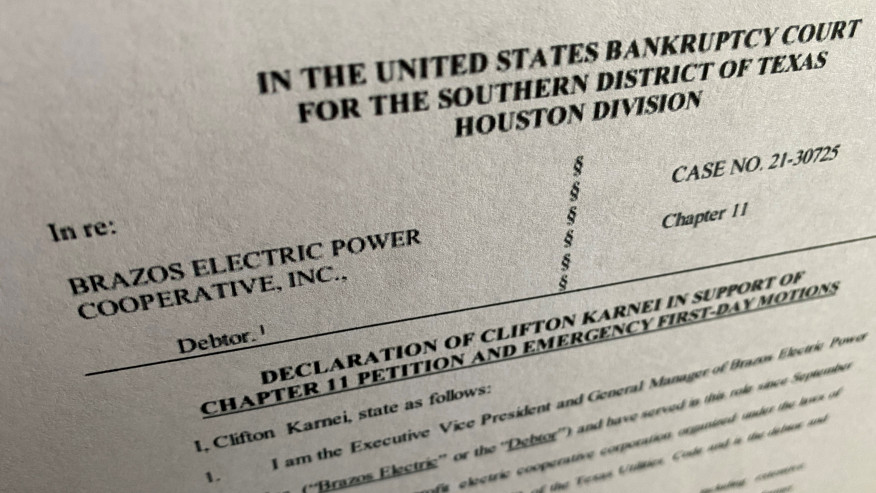WACO, Texas (KXAN) — While Texans were trying to survive the worst winter storm to hit the power grid in the early morning hours of Feb. 15, the people who oversee that grid were working on plans to save it.
That plan ultimately led the Electric Reliability Council of Texas and the Public Utility Commission of Texas to drive the price of wholesale energy produced in the grid to $9,000 per megawatt hour. That price was $20.79 per megawatt hour in the weeks before the storm hit, according to ERCOT records.
The pricing increase was to ensure regional utilities were cutting the amount of power ERCOT ordered in its Feb. 15 Level 3 Energy Emergency Alert, which resulted in 4.1 million Texans losing power.
That pricing has driven Brazos Electric Power Cooperative, who bills itself as Texas’ largest and oldest generation and transmission cooperative, to file a petition for bankruptcy.
“The consequences of these prices were devastating,” Brazos Electric Power Cooperative Executive Vice President and General Manager Clifton Karnei wrote in the cooperative’s March 1 Chapter 11 bankruptcy petition.
A Chapter 11 filing is designed to allow the cooperative to continue operating and is designed as a way for a debtor to reorganize and pay creditors over time, according to the United States Court’s website.
Brazos Electric’s coverage area contains 68 counties spread between Houston and the Texas Panhandle, according to the cooperative’s website.
The filing shows a list of entities to whom the cooperative owes the largest amounts of money.
ERCOT is the cooperative’s largest debt, coming in at over $1.8 billion. The cooperative’s second-largest debt is to Bank of America, which is for a line of credit totaling $479.9 million.

Brazos Electric lists the ERCOT debt as “disputed.”
“As the month of February 2021 began, the notion that a financially stable cooperative such as Brazos Electric would end the month preparing for bankruptcy was unfathomable,” Karnei wrote in the filing.
Karnei was part of the ERCOT board for more than a decade and was on the board in 2011, the same year the Federal Energy Regulatory Commission issued a report detailing how ERCOT could prevent winter failures within its statewide power grid. A February 2011 winter storm left more than three million Texans without power for days as blackouts rolled across Texas.
Part of the 2011 report detailed how winterizing the power grid would help prevent the massive power outages of 2011 from happening again.
Then the winter storm of 2021 hit, cutting power to four million Texans and considered the cause of dozens of deaths across the state over the course of four days.
Karnei resigned from the ERCOT board last week — becoming the seventh resignation to hit the board in response to the fallout over power grid failure.
Karnei’s resignation happened the same week bills totaling $2.1 billion owed to ERCOT came due.
On Feb. 25, the day Karnei resigned, Brazos Electric Cooperative sent ERCOT a letter explaining the cooperative would not pay the bill.
The Brazos Electric filing claims the ERCOT wholesale market will see $55 billion in charges from the week-long winter storm timeframe; four years’ worth of charges from a single week.
BRAZOS ELECTRIC BANKRUPTCY DECLARATION Download
“Brazos Electric will not foist this catastrophic ‘black swan’ financial event onto its members and their consumers, and commenced this bankruptcy to maintain the stability and integrity of its entire
electric cooperative system,” Karnei wrote in the bankruptcy declaration filed in Houston on March 1.
Brazos Electric Cooperative’s total power costs for all of 2020 totaled $774 million.
The 2011 Winter Storm
Karnei was on the ERCOT board when the Federal Energy Regulatory Commission issued a report urging Texas’ power grid to winterize. The 357-page report detailed nine separate findings that showed exactly what happened inside ERCOT’s power grid that left millions without power for so long.
According to the FERCE report, the single largest problem during the cold weather event was the freezing of instrumentation and equipment.
The report continued:
“Many generators failed to adequately prepare for winter, including the following: failed or inadequate heat traces, missing or inadequate wind breaks, inadequate insulation and lagging (metal covering for insulation), failure to have or to maintain heating elements and heat lamps in instrument cabinets, failure to train operators and maintenance personnel on winter preparations, lack of fuel switching training and drills, and failure to ensure adequate fuel.”
The report revealed one-third of ERCOT’s fleet was off line at one point in the 2011 storm.
“These extensive generator failures overwhelmed ERCOT’s reserves, which eventually dropped below the level of safe operation. Had ERCOT not acted promptly to shed load, it would very likely have suffered widespread, uncontrolled blackouts throughout the entire ERCOT Interconnection,” the 2011 report stated.
On Feb. 17, KXAN contacted Karnei at his office requesting an interview concerning the steps he took as an ERCOT board member in 2011 to ensure the state’s power grid was protected from winter weather.
2011 FEDERAL ENERGY REGULATORY COMMISSION REPORT ON TX POWER OUTAGES Download
Karnei never responded.
In Karnei’s bankruptcy filing, he referenced the lack of winterization that’s still plaguing the Texas power grid.
“Texas’ generating plants, pipelines, and wind turbines are constructed to operate in extreme
summer temperatures and are not winterized in the manner and to the degree that is common in
more traditionally cold-weather states,” Karnei wrote.
The continuing lack of winterization following the 2011 FERC report was also a topic of lawmakers’ questions during last week’s hearings inside the Texas Capitol. Sen. Roland Gutierrez said during the hearing he was planning to file a bill to force winterization inside Texas’ power grid.
